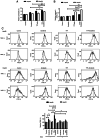Tumor-treating fields in combination with sorafenib restrain the proliferation of liver cancer in vitro
- PMID: 36039063
- PMCID: PMC9404698
- DOI: 10.3892/ol.2022.13458
Tumor-treating fields in combination with sorafenib restrain the proliferation of liver cancer in vitro
Abstract
Liver cancer is a common malignancy worldwide, with a poor prognosis and a high recurrence rate despite the available treatment methodologies. Tumor-treating fields (TTFields) have shown good preclinical and clinical results for improving the prognosis of patients with glioblastoma and malignant pleural mesothelioma. However, there is minimal evidence for the effect of TTFields on other cancer types. Thus, the present study aimed to investigate the therapeutic efficacy of TTFields in an in vitro model, and to further elucidate the underlying mechanisms. In the present study, two hepatocellular carcinoma (HCC) cell lines (Hep3B and HepG2) were treated with TTFields (intensity, 1.0 V/cm; frequency, 150 kHz) in order to determine the potential antitumor effects of this approach. TTFields significantly inhibited the proliferation and viability of HCC cell lines, as measured using Trypan blue and MTT assays, as well as colony formation in three-dimensional cultures. The TTFields also significantly inhibited the migration and invasion of HCC cells in Transwell chamber and wound-healing assays. Moreover, TTFields enhanced the production of reactive oxygen species in the cells and increased the proportion of apoptotic cells, as evidenced by increased caspase-3 activity, as well as PARP cleavage in western blotting experiments. All of these effects were increased following the application of TTFields in combination with the multi-kinase inhibitor sorafenib, which demonstrated a synergistic effect. Thus, to the best of our knowledge, these results demonstrate for the first time the potential of TTFields in improving the sensitivity of HCC cells to sorafenib, which may lay the foundation for future clinical trials for this combination treatment strategy.
Keywords: apoptosis; liver cancer; sorafenib; tumor-treating fields.
Copyright © 2022, Spandidos Publications.
Conflict of interest statement
The authors declare that they have no competing interests.
Figures





Similar articles
-
Effectiveness of tumor‑treating fields to reduce the proliferation and migration of liposarcoma cell lines.Exp Ther Med. 2023 Jun 9;26(2):363. doi: 10.3892/etm.2023.12062. eCollection 2023 Aug. Exp Ther Med. 2023. PMID: 37408858 Free PMC article.
-
Tumor Treating Fields (TTFields) Concomitant with Sorafenib Inhibit Hepatocellular Carcinoma In Vitro and In Vivo.Cancers (Basel). 2022 Jun 15;14(12):2959. doi: 10.3390/cancers14122959. Cancers (Basel). 2022. PMID: 35740624 Free PMC article.
-
Functional Biological Activity of Sorafenib as a Tumor-Treating Field Sensitizer for Glioblastoma Therapy.Int J Mol Sci. 2018 Nov 21;19(11):3684. doi: 10.3390/ijms19113684. Int J Mol Sci. 2018. PMID: 30469352 Free PMC article.
-
A review of tumor treating fields (TTFields): advancements in clinical applications and mechanistic insights.Radiol Oncol. 2023 Sep 4;57(3):279-291. doi: 10.2478/raon-2023-0044. eCollection 2023 Sep 1. Radiol Oncol. 2023. PMID: 37665740 Free PMC article. Review.
-
Tumor treating fields: narrative review of a promising treatment modality for cancer.Chin Clin Oncol. 2023 Dec;12(6):64. doi: 10.21037/cco-23-82. Epub 2023 Nov 2. Chin Clin Oncol. 2023. PMID: 37953242 Review.
Cited by
-
Pulsed Electric Fields in Oncology: A Snapshot of Current Clinical Practices and Research Directions from the 4th World Congress of Electroporation.Cancers (Basel). 2023 Jun 25;15(13):3340. doi: 10.3390/cancers15133340. Cancers (Basel). 2023. PMID: 37444450 Free PMC article. Review.
-
Advancement in tumor treating fields of mechanism, clinical applications, and future directions.Discov Oncol. 2025 Jun 10;16(1):1049. doi: 10.1007/s12672-025-02861-0. Discov Oncol. 2025. PMID: 40495024 Free PMC article. Review.
-
Design and Modeling of a Device Combining Single-Cell Exposure to a Uniform Electrical Field and Simultaneous Characterization via Bioimpedance Spectroscopy.Sensors (Basel). 2023 Mar 25;23(7):3460. doi: 10.3390/s23073460. Sensors (Basel). 2023. PMID: 37050519 Free PMC article.
-
Effectiveness of tumor‑treating fields to reduce the proliferation and migration of liposarcoma cell lines.Exp Ther Med. 2023 Jun 9;26(2):363. doi: 10.3892/etm.2023.12062. eCollection 2023 Aug. Exp Ther Med. 2023. PMID: 37408858 Free PMC article.
-
Theory and application of TTFields in newly diagnosed glioblastoma.CNS Neurosci Ther. 2024 Mar;30(3):e14563. doi: 10.1111/cns.14563. CNS Neurosci Ther. 2024. PMID: 38481068 Free PMC article. Review.
References
LinkOut - more resources
Full Text Sources
Research Materials
